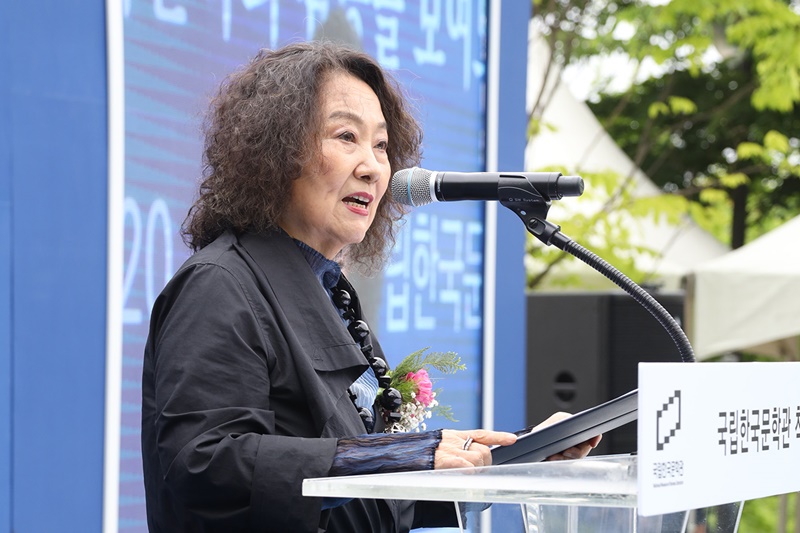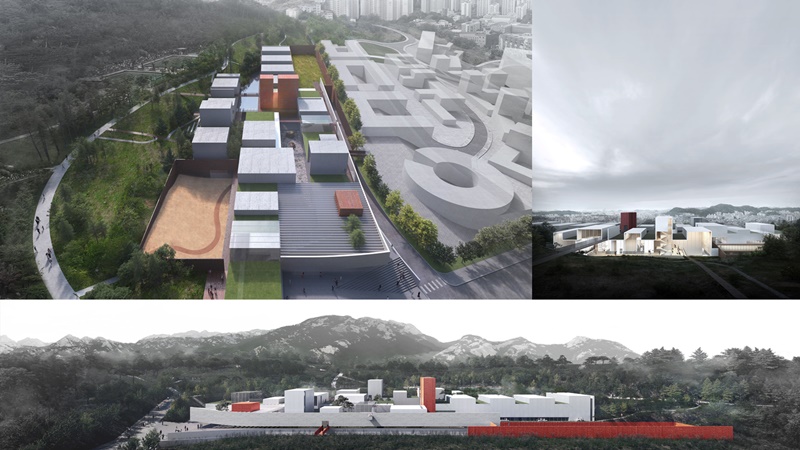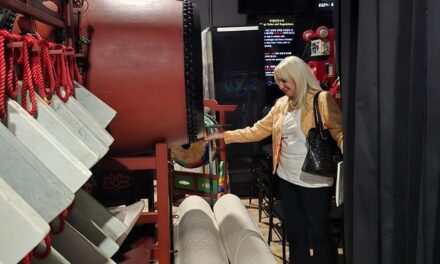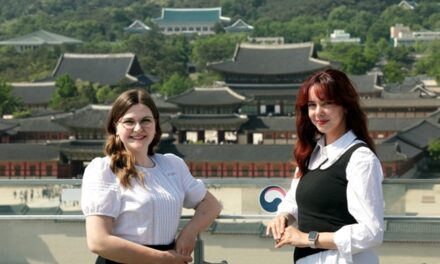
Moon Jung-hee, director of the forthcoming National Museum of Korean Literature, on May 20 gives the opening speech at the groundbreaking ceremony for the facility in Seoul’s Eunpyeong-gu District. (National Museum of Korean Literature)
By Wu Jinhua
The groundbreaking ceremony for the National Museum of Korean Literature was held on May 20 at Gijachon Neighborhood Park in Seoul’s Eunpyeong-gu District.
Minister of Culture, Sports and Tourism Yu In Chon, the heads of the country’s leading literary organizations, donors of literary materials and residents came out to celebrate the launch of the facility’s construction.
Slated for opening in the second half of 2026, the museum will have a total floor area of 14,993 square m and site area of 13,248 square m on two basement and two above-ground floors. The construction period is 2021-26 at an estimated cost of KRW 71.6 billion.
Minister Yu said at the ceremony, “Starting with the groundbreaking ceremony for the literature museum, a long-awaited project of the literary community, we will push for the necessary support policies at each stage and subject like creation, presentation and publication to promote Korean literature.”
Though a slow process to get the first shovel in the ground, everyone’s efforts to build the museum have never stopped as a work still in progress. The facility in two years will be ready to powerfully spread its wings to the world as a key institution and space for literature.
The following are the excerpts from Korea.net’s May 28 interview with the museum’s inaugural director Moon Jung-hee.
Ground was broken on May 20 for the National Museum of Korean Literature, a long-awaited project in domestic literature.
The first step has been taken eight years after the Literature Promotion Act was enacted in 2016 and five years after the museum’s incorporation in 2019. This is highly significant because we can now initiate numerous projects previously stalled by the lack of a dedicated literary buliding. Since it took a long time, we will showcase to the public the excitement and beauty of literature after the museum opens in 2026.
What is the core business of the museum, the first of its kind in the nation?
Collecting and managing materials form the basic mission of our institution, which seeks to preserve and pass on heritage from the past. We can say the museum was created to preserve important materials on Korean literature that could have been damaged or destroyed during the Japanese colonial period and wars.
Most literary materials are made of paper, meaning they are highly susceptible to environmental damage. This attests to the importance of preserving them as soon as possible. Over the years, the museum has collected original materials of Korean literature ranging from classics to contemporary works, and preserved and managed the most damaged among them. These materials are of great significance as part of our literature’s history and legacy for the future. I think this is also an important project that a national institution like the National Museum of Korean Literature should take on.
In the future, we plan to digitize collected materials so that they can conveniently be viewed and used anywhere in the world. We will also promote links and exchange projects based on Korean literature exhibitions to spread the achievements of our literature.
What roles will the museum play?
The National Museum of Korean Literature will conduct all literary projects specified in the Literature Promotion Act. As a central facility encompassing the country’s literary museums, it will play a variety of roles to promtoe Korean literature by closely working with regional museums.
It will also collect and preserve literary materials and research and study Korean literature to shed light on its development. Events we will host include exhibitions using literary materials, academic conferences, readings and meetings with authors.
Many translations of Korean literary works have gained global recognition.
This is welcome and encouraging. Korean literature is actually comparable to others in the world; it’s just taken longer to gain awareness and recognition. I think this is due in large part to growing respect for and attention to linguistic and cultural diversity. And government efforts to consistently back the translation of Korean literature and exchanges with writers abroad have also played a significant role.
The stronger the roots, the farther the branches reach and the more beautiful the colors of flowers are. I think that the stronger the foundation for the creation and enjoyment of Korean literature, the more love Korean authors will get and their works will resonate more strongly with diverse readers abroad. Now is the time for efforts to enhance the value of Korean literature, the foundational content of Korean culture.
Any concluding message to Korea.net readers and fans of Korean literature?
Korean literature is an important record of our lives and a source of imagination. This is why literature is said to be the source material for all culture and arts. Our literature has faced many difficulties over the years but seen gradual development. Today, it is expressed and adapted into many artistic genres such as movies, dramas, webtoons, dance and theater. Our literature will keep developing along with our culture and arts, and the National Museum of Korean Literature will be at the center of this. We ask for your continued interest and support until the museum’s opening.

These are aerial projections of the forthcoming National Museum of Korean Literature in Seoul’s Eunpyeong-gu District. (Ministry of Culture, Sports and Tourism)
jane0614@korea.kr




